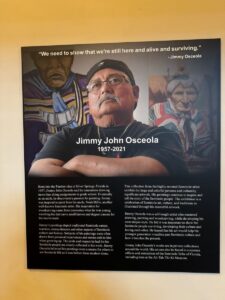
Credit: Sofia De La Espriella
Although many Seminoles were forcibly moved to Oklahoma, a small number remained hidden in the Everglades, earning them the distinction of being the only “unconquered” Native American tribe in the United States.
Located in the heart of the Everglades on the Big Cypress Seminole Indian Reservation, the Ah-Tah-Thi-Ki museum allows visitors the opportunity to learn about the history and heritage of the Seminole tribe of Florida.
Ah-Tah-Thi-Ki, meaning, “a place to learn, a place to remember” in the Seminole language, is a cultural and historical center in the city of Clewiston, with over 30,000 artifacts that offer a glimpse into centuries of Seminole life, culture, and resilience.
Opened in 1997, this museum was created to preserve and celebrate Seminole heritage, and it is owned and operated by the Seminole Tribe of Florida. According to the 18-minute film that plays at the entrance of the museum, former tribal chairman James Billie chose to build the museum at Big Cypress in honor of the legendary Seminole leader Sam Jones, or Abiaki.
During the Seminole Wars, Jones led his people into the Everglades, resisting American forces and forced relocation. Today, “the museum stands as a tribute to the Seminoles’ enduring strength and spirit,” the video states.
The Seminole people’s ancestors were the Creek Indians of Georgia and Alabama, who migrated into Florida in the 1700s to escape the Europeans.
They established a distinct culture and gained prominence during the 19th century, resisting the U.S. government attempts to relocate them during the Indian Removal Act era. Although many Seminoles were forcibly moved to Oklahoma, a small number remained hidden in the Everglades, earning them the distinction of being the only “unconquered” Native American tribe in the United States.
Today, over 2,000 Seminoles reside across six reservations in Florida, located in Hollywood, Big Cypress, Brighton, Immokalee, Fort Pierce, and Tampa.
Early tribes such as the Calusa, Apalachee, Tocobaga, and Timucua thrived for thousands of years, sustained by Florida’s rich environment and natural resources. These groups built sophisticated societies, however, their way of life was forever altered with the arrival of European explorers in the 16th century.
While the Seminole people are often the focus of Florida’s Indigenous history, they were far from the only Native group to inhabit the state. Dozens of tribes, such as the Tequesta, Mayaimi, and Jeaga, once lived in the region. However, due to colonization and its effects, many of these tribes disappeared by the late 18th century.
The past and their legacy
The museum also features the work of Jimmy John Osceola, a prominent Seminole artist known for his paintings and woodwork that illustrate Seminole life and traditions.

Credit: Sofia De La Espriella
Osceola, born in 1957, was part of the Panther clan and began his artistic journey by learning from family members and drawing on memories of his childhood. His artwork captures Seminole camps, traditional ceremonies, and the resilience of his people. Osceola believed that art was a powerful way to keep Seminole culture alive.
The museum’s collection shows the Seminoles’ everyday life and spiritual practices, featuring traditional tools, textiles, and vibrant clothing.
One exhibit, titled “The Happy Couple,” shows a traditional Seminole marriage ceremony. In the display, a young couple hesitantly glances at each other, symbolizing the start of a new life together. The display explains that the groom presents his bride with gifts, symbolizing his commitment to care for her. This exhibit captures a slice of Seminole culture, celebrating family and community ties through marriage.
Another unique display honors Connie Gowen, a Seminole woman who has dedicated her craft to making traditional patchwork turbans for Florida State University’s homecoming ceremonies. This craft has been passed down through her family, a tradition she inherited and continues to share with pride.

Credit: Sofia De La Espriella
Her work reflects the Seminole commitment to preserving cultural identity through clothing and craft, as seen in the vibrant red and white feathers, and intricate stitching on the turban she created.
Visitors can also walk along a mile-long boardwalk through a peaceful forest, learning how the Seminoles’ history and lifestyle are closely tied to the landscape of South Florida.
Balancing tradition and modernization
The Seminoles’ resilience allowed them to survive and thrive into the modern era. In 1957, the Seminole Tribe adopted a constitutional form of government, securing federal recognition and the ability to govern themselves. This independence empowered the tribe to pursue economic self-sufficiency, starting their way into industries such as tourism, agriculture, and gaming. Their success in gaming, including ventures like Hard Rock International, has provided financial resources to support community services and projects like the Ah-Tah-Thi-Ki Museum.
Visit the Ah-Tah-Thi-Ki Museum
Big Cypress Seminole Indian Reservation
34725 West Boundary Road, Clewiston, FL 33440
Open 7 days a week, 9 a.m. to 5 p.m.
For more information, call 877-902-1113 or email [email protected]

Explore 10 of the oldest buildings in Florida
From the state’s largest cigar factory to a 350-year-old military fort, the oldest buildings in Florida contain multitudes of history. It’s no...

From Roberto Clemente to the Dupont Plaza’s fire: Puerto Rico’s unforgettable December tragedies
These are some of the most significant moments in the island's history that disrupted the holiday season. December, a month typically associated...

5 places in Florida to donate clothes, shoes, and more
Decluttering your home can provide such a satisfying feeling of accomplishment. After sorting through all of your belongings and determining what...

8 Orlando hotels that pack as much fun as the theme parks
With waterslides, family arcades, playgrounds for the kids, and spas for mom and dad, these Orlando hotels will make your vacation unforgettable!...




